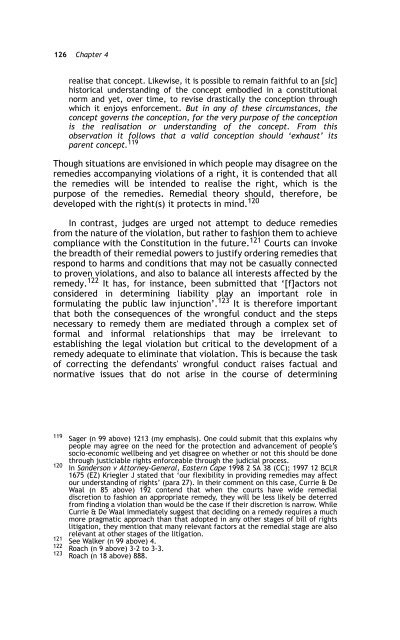LITIGATING SOCIO-ECONOMIC RIGHTS IN SOUTH AFRICA - PULP
LITIGATING SOCIO-ECONOMIC RIGHTS IN SOUTH AFRICA - PULP
LITIGATING SOCIO-ECONOMIC RIGHTS IN SOUTH AFRICA - PULP
You also want an ePaper? Increase the reach of your titles
YUMPU automatically turns print PDFs into web optimized ePapers that Google loves.
126 Chapter 4<br />
realise that concept. Likewise, it is possible to remain faithful to an [sic]<br />
historical understanding of the concept embodied in a constitutional<br />
norm and yet, over time, to revise drastically the conception through<br />
which it enjoys enforcement. But in any of these circumstances, the<br />
concept governs the conception, for the very purpose of the conception<br />
is the realisation or understanding of the concept. From this<br />
observation it follows that a valid conception should ‘exhaust’ its<br />
parent concept. 119<br />
Though situations are envisioned in which people may disagree on the<br />
remedies accompanying violations of a right, it is contended that all<br />
the remedies will be intended to realise the right, which is the<br />
purpose of the remedies. Remedial theory should, therefore, be<br />
developed with the right(s) it protects in mind. 120<br />
In contrast, judges are urged not attempt to deduce remedies<br />
from the nature of the violation, but rather to fashion them to achieve<br />
compliance with the Constitution in the future. 121 Courts can invoke<br />
the breadth of their remedial powers to justify ordering remedies that<br />
respond to harms and conditions that may not be casually connected<br />
to proven violations, and also to balance all interests affected by the<br />
remedy. 122 It has, for instance, been submitted that ‘[f]actors not<br />
considered in determining liability play an important role in<br />
formulating the public law injunction’. 123 It is therefore important<br />
that both the consequences of the wrongful conduct and the steps<br />
necessary to remedy them are mediated through a complex set of<br />
formal and informal relationships that may be irrelevant to<br />
establishing the legal violation but critical to the development of a<br />
remedy adequate to eliminate that violation. This is because the task<br />
of correcting the defendants' wrongful conduct raises factual and<br />
normative issues that do not arise in the course of determining<br />
119<br />
Sager (n 99 above) 1213 (my emphasis). One could submit that this explains why<br />
people may agree on the need for the protection and advancement of people’s<br />
socio-economic wellbeing and yet disagree on whether or not this should be done<br />
through justiciable rights enforceable through the judicial process.<br />
120 In Sanderson v Attorney-General, Eastern Cape 1998 2 SA 38 (CC); 1997 12 BCLR<br />
1675 (EZ) Kriegler J stated that ‘our flexibility in providing remedies may affect<br />
our understanding of rights’ (para 27). In their comment on this case, Currie & De<br />
Waal (n 85 above) 192 contend that when the courts have wide remedial<br />
discretion to fashion an appropriate remedy, they will be less likely be deterred<br />
from finding a violation than would be the case if their discretion is narrow. While<br />
Currie & De Waal immediately suggest that deciding on a remedy requires a much<br />
more pragmatic approach than that adopted in any other stages of bill of rights<br />
litigation, they mention that many relevant factors at the remedial stage are also<br />
relevant at other stages of the litigation.<br />
121 See Walker (n 99 above) 4.<br />
122<br />
Roach (n 9 above) 3-2 to 3-3.<br />
123 Roach (n 18 above) 888.
















